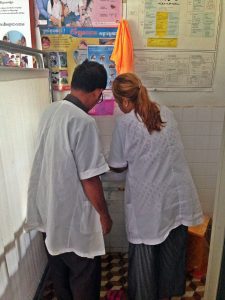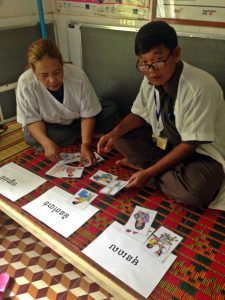This project is made possible through the partnership of WATER CHARITY and the NATIONAL PEACE CORPS ASSOCIATION. ![]()
This project has been completed. To read about the conclusion, CLICK HERE.
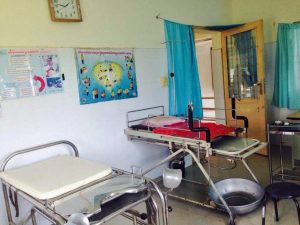 Location
Location
This project summary has been redacted for security reasons to omit the specific project location.
Xxxx Xxxx Commune, Tram Kak District, Takeo Province, Cambodia
Community Description
In the rural community of Xxxx Xxxx Commune, many families are rice farmers. The eighteen villages that Xxxx Xxxx Health Center serves, thrive off the land of lush green rice fields during the rainy season and dry, cracked dirt during the dry season.
Although the commune serves over 1,000 people, the families are intertwined as one large family. Like many communities in Cambodia, families in the area are recovering financially, structurally, physically, mentally, and developmentally from their broken past.
Problem Addressed
In 2015, a new maternity ward was built without consideration of distance and accessibility to the health center’s current water source. Currently, there is no running water in the delivery room or the bathroom attached to the maternity ward.
During delivery, the midwives ask the family of the woman in labor to take a bucket to fill it up with water located about 20 meters from the delivery room. With this one bucket of water, the midwives perform their hand washing and washing of medical supplies.
The current water source is a small well that can be unreliable during the hot season. Therefore, the staff needs to pull water from the pond, which is not hygienic.
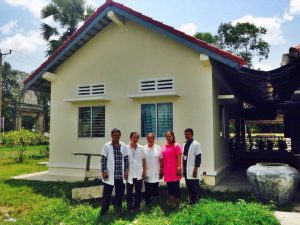 In addition to the lack of running water, the community has not had any formal education on proper hand-washing techniques. Proper hygiene practices go beyond the health center. The community does not know the appropriate elements and techniques needed to wash their hands to prevent illnesses.
In addition to the lack of running water, the community has not had any formal education on proper hand-washing techniques. Proper hygiene practices go beyond the health center. The community does not know the appropriate elements and techniques needed to wash their hands to prevent illnesses.
Project Description
This project is to build a reliable, running water source at the health center.
Both the delivery room and the bathroom have access points (i.e. sink, toilet, cistern) that were installed during the construction of the building in 2015. A well and tank will be constructed at a location behind the maternity ward near the delivery room and the bathroom.
Water will be pumped from the well up to the tank using an electric motor. The water will be stored in the tank until someone turns on the faucet in the maternity ward. The water will then flow from the tank to the delivery room or bathroom.
The base of the tank will be constructed from concrete and be 2 m x 2 m. The plastic tank will hold 1,500 L of water. The structure of the tank will include a metal roof to protect the tank and water inside from overheating.
The construction of the well, tank, and pipes will be done by local companies specializing in well and tank construction.
The health center staff will undergo training involving knowledge and skills about why, how, and when to wash their hands
In addition, the midwives will be trained on necessary knowledge to be passed on to new mothers about hygiene-related to post-natal care involving breastfeeding, bottle feeding, personal hygiene, and hygiene of their baby.
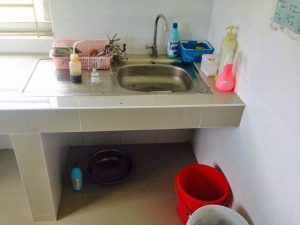 Once all nine staff members can demonstrate and explain hand washing, they will then use this knowledge to lead training. The first training will be with the Village Health Volunteers. They will go through a similar workshop related to critical information about hand-washing and skills on how to train others.
Once all nine staff members can demonstrate and explain hand washing, they will then use this knowledge to lead training. The first training will be with the Village Health Volunteers. They will go through a similar workshop related to critical information about hand-washing and skills on how to train others.
In November, at the start of the new school year, the health center staff will lead training with class monitors and selected teachers. All the training will cover proper hand-washing techniques, critical hand-washing times, and knowledge of hygiene.
The health center staff has accumulated savings over the past few years to help contribute 25% for supplies, materials, and labor of the project. Their contributions will mainly go toward training materials and their contribution of time to train others in the community.
Recently, the health center chief installed wall shelves and soap to accompany the sinks in the old health center as well as the maternity ward.
Project Impact
Over 1,000 people will benefit from this project.
Peace Corps Volunteer Directing Project
Shelby Farmer
Monitoring and Maintenance
The staff maintains the facilities on a daily basis. The health center chief takes responsibility in budgeting and contacting individuals to maintain the running water and in restocking the soap every month through the monthly budget assigned to the health center at the commune level.
In addition, the midwives’ training on hygiene related to maternal health care will be sustained through the constant flow of patients who come in for ANC and PNC check-ups. The sustainability of knowledge will occur during midwives’ interaction with this target audience.
In addition, the staff member responsible for outreach meets with the Village Health Volunteers when going to their village. He will assess retained knowledge of hand-washing during his outreach.
Comments
The new well and tank will provide running water, allowing midwives to perform safer, more hygienic deliveries, and will provide an opportunity to educate the community about basic hygiene.
This project has been paid for through a grant from the International Foundation.
Conclusion of Tram Kak District Water Project – Cambodia
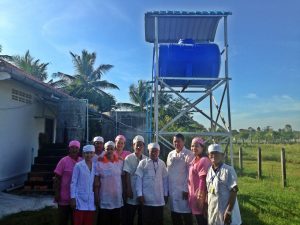 This project has been completed under the direction of Peace Corps Volunteer Shelby Farmer. To read about the start of the project, CLICK HERE.
This project has been completed under the direction of Peace Corps Volunteer Shelby Farmer. To read about the start of the project, CLICK HERE.
The project was designed to build a reliable, running water source at the health center.
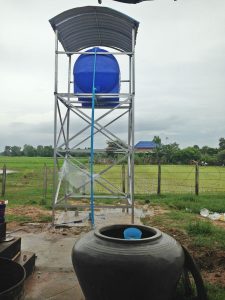 Shelby reports:
Shelby reports:
The Clean Care, Clean Community Project has created a healthier environment where community members feel safe and their health a priority. The maternity ward in the Health Center now has access to running water. This running water has increased proper handwashing of midwives before and after contact with patients.
Prior to the installation of running water, the midwives would ask the family of the woman in labor to take large buckets out to the cistern, or the pond during the drier months, to bring buckets of water into the maternity room. These buckets of water created a barrier for the midwives to easily and properly wash their hands. Now with a turn of a faucet, the midwives can comfortably and properly wash their hands as well as the surgical tools used for women’s health, therefore decreasing risk of infection.
The work that was done using Water Charity’s funding included installing a 35-meter well. This allows more reliable access to water since the rain water dries up during the drier months. Once the well was installed, a large structure that included a metal frame and 1,500L storage tank was built to allow the well water to be stored for high-pressure flow.
Pipes were then installed to deliver the water to the maternity ward. Some funding also helped develop health education trainings that discussed hand washing importance for the health center staff as well as educating midwifes about post-natal care hygiene to the new mothers and their families. In addition, these trainings extended to village health volunteers and the local primary school.
The progression of the project began with the Peace Corps Volunteer and her midwife counterpart attending a project design and management workshop provided by Peace Corps. The plan for this project was then presented to the health center staff. Once the project was fully funded and the community contributions were in place, the health center chief coordinated with community members such as construction workers and hardware stores to help with the project.
The installation of the well and motor occurred over a course of three days. The construction of the framework and water tank was more expensive than budgeted for, so we waited a few weeks in order to find more community contribution, which was provided by donations of the health center staff. Once enough funding was available, the structure was built over a course of a week.
Pipes were then connected from the new structure to the maternity ward. When the first flow of water was tested, the health center found that there were issues with the pipes and that the flow of water was very limited. Since no grant money was allotted for this unforeseen issue, the health center had to wait for monetary budget from the commune level to pay someone to come and check the pipes.
Once the pipes were cleaned out and the flow was restored, the maternity ward had access to flowing water. Along with the physical construction of flowing water, trainings on water and sanitation hygiene were conducted with the health center staff and the community. Every member of the staff was trained in proper handwashing and understanding of hygiene. In addition, the midwifes were trained in proper use of the facility as well as post-natal care hygiene that is to be taught to new mothers and their families after delivery. Lastly, outreach was conducted with the support of the health center staff teaching village health volunteers and the school about proper handwashing techniques.
The end result of this project has provided running water to a health center that serves 1,800 people. This running water provides easy access to proper handwashing techniques and cleaning of surgical equipment in a rural setting. It decreases the risk of infection in the clinical setting. The project has allowed an opportunity for behavior change regarding sanitation and hygiene within the community.
Comments from community:
“As a staff, we want to say thank you very much for providing an opportunity to better our community.”—Deputy Health Center Chief
“We treat the health center as a second home. With this new infrastructure, we feel like our home is complete.” –Midwife
We extend our thanks to Shelby for completing this important project.
